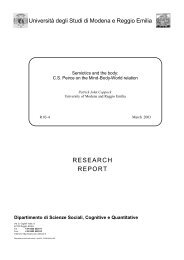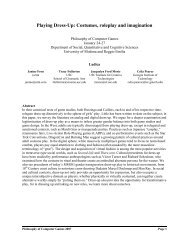The Irreducible Self: Image Studies of First Person
The Irreducible Self: Image Studies of First Person
The Irreducible Self: Image Studies of First Person
Create successful ePaper yourself
Turn your PDF publications into a flip-book with our unique Google optimized e-Paper software.
43. Philosophy: Concepts as Games<strong>The</strong> first person has <strong>of</strong>fered a problem to Philosophy since the classical era. Undoubtedly themost prominent theory <strong>of</strong> subjectivity or self-consciousness is the Cartesian concept <strong>of</strong> the rescogitans; Descartes thinks <strong>of</strong> the world as something opposed to the spectator. Even the body<strong>of</strong> the I is only a part <strong>of</strong> the extensional world, which separates it from the mind. That is thereason why in Descartes’ skepticism, the existence <strong>of</strong> the body can be doubtful, but not theexistence <strong>of</strong> the res cogitans. To put this in terms <strong>of</strong> the video game, Descartes’ ontology isthat <strong>of</strong> a classical computer game in which the visible world also appears as a res extensa.One need only recall games like FROGGER or ZAXXON, in which the acting person, animal orvehicle is part <strong>of</strong> the objective world. It is presented as an extended corpus amongst otherobjects that persist within the virtual world. That corpus is what is called an “avatar”. Eventhough the avatar can be steered freely by the player, the figure itself is part <strong>of</strong> the game worldand subordinated to its defined physical conditions. Freedom only exists on the side <strong>of</strong> theplayer and on his or her side <strong>of</strong> the screen. <strong>The</strong> player is situated in the res cogitans, whereasthe avatar is located in the realm <strong>of</strong> the res extensa.In my opinion this is one reason why many video game theorists tend to speak <strong>of</strong> computergames spaces as “representational spaces.” In many games the interaction with the objectsthat appear is based on a representational relation in the Cartesian sense. If you think <strong>of</strong>Descartes’ model <strong>of</strong> vision, which is based on the functionality <strong>of</strong> a cameraobscura (Crary 1990), one can be tempted to believe that the human mind is an entity,separated from the world and looking at its objects on a screen. As in the camera obscura, theviewer is settled inside an apparatus that represents the outside world. To a player <strong>of</strong> aclassical computer games the visual presentation <strong>of</strong> that virtual world appears to be arepresentation <strong>of</strong> it. One does not steer himself or herself, but rather steers an agent <strong>of</strong> the self.In philosophy, such a situation provokes the so-called “homunculus fallacy”: if the mindobserves the world (hence, a representation <strong>of</strong> it) from the inside, who or what is the instanceperceiving what the mind sees?<strong>The</strong> Cartesian concept <strong>of</strong> the self has been heavily criticized throughout modern philosophy.One <strong>of</strong> its critics was Immanuel Kant, who argued that the self is only an idea that allows usto ensure consistency among our perceptions <strong>of</strong> the world. To Kant, it is, however, atranscendental condition (for the subject to be). Reacting to Kant, Ludwig Wittgenstein wrotein the Tractatus: “<strong>The</strong> subject does not belong to the world but it is a limit <strong>of</strong> theworld” (Prop. 5.632). By some interpretations, this quotation – in the light <strong>of</strong> the “linguistic






